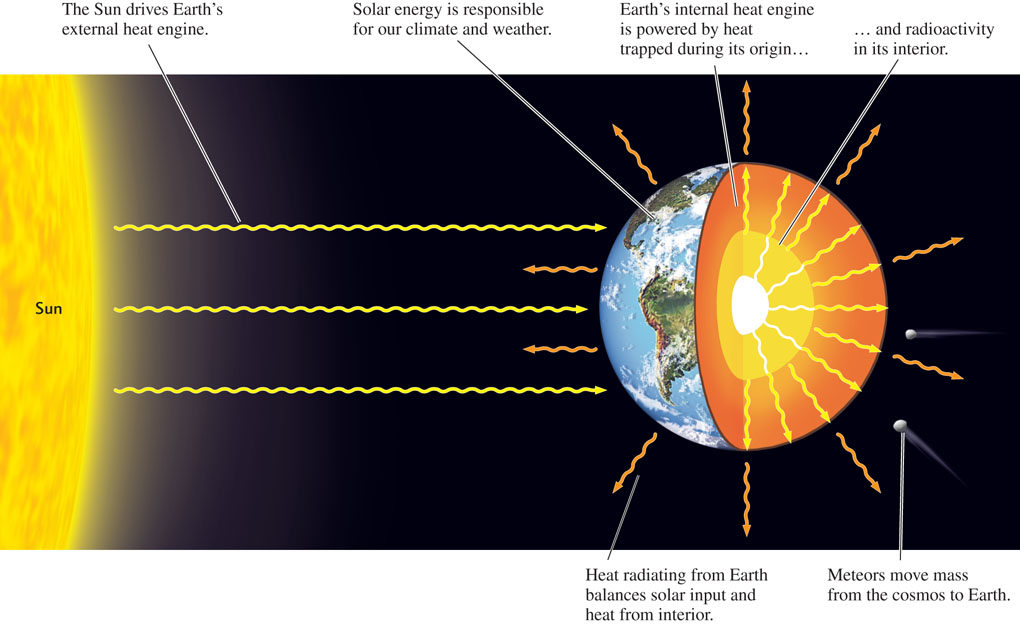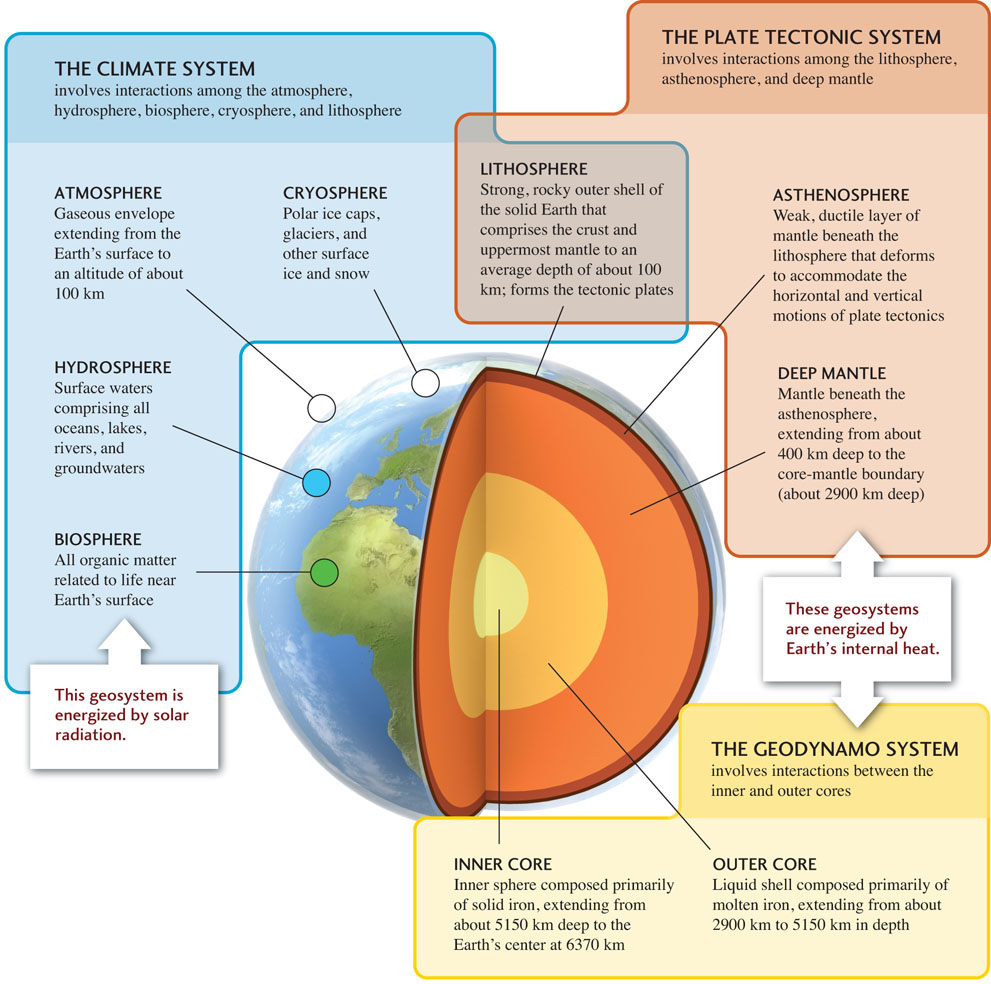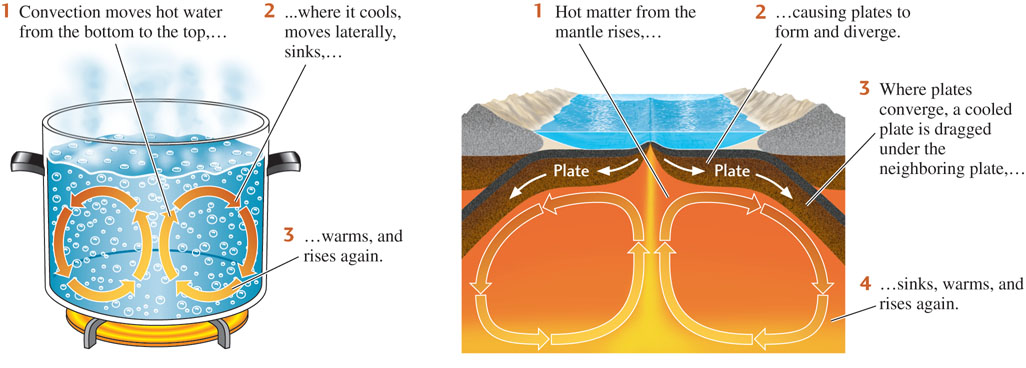Earth as a System of Interacting Components
Earth is a restless planet, continually changing through geologic activity such as earthquakes, volcanoes, and glaciation. This activity is powered by two heat engines: one internal, the other external (Figure 1.13). A heat engine—for example, the gasoline engine of an automobile—transforms heat into mechanical motion or work. Earth’s internal heat engine is powered by the heat energy trapped in its deep interior during its violent origin and released inside the planet by radioactivity. This internal heat drives movement in the mantle and core, supplying the energy that melts rock, moves continents, and lifts up mountains. Earth’s external heat engine is driven by solar energy: heat supplied to Earth’s surface by the Sun. Heat from the Sun energizes the atmosphere and oceans and is responsible for Earth’s climate and weather. Rain, wind, and ice erode mountains and shape the landscape, and the shape of the landscape, in turn, influences the climate.

All the parts of our planet and all their interactions, taken together, constitute the Earth system. Although Earth scientists have long thought in terms of natural systems, it was not until the late twentieth century that they had the tools to investigate how the Earth system actually works. Networks of instruments and Earth-orbiting satellites now collect information about the Earth system on a global scale, and computers are powerful enough to calculate the mass and energy transfers within the system. The major components of the Earth system can be represented as a set of domains, or “spheres” (Figure 1.14). We have discussed some of these components already; we will define the others shortly.

14
We will talk about the Earth system throughout this textbook. Let’s get started by looking at some of its basic features. The Earth system is an open system that exchanges energy and mass with its surroundings (see Figure 1.14). Radiant energy from the Sun energizes the weathering and erosion of Earth’s surface, as well as the growth of plants, which feed almost all living things. Earth’s climate is controlled by the balance between the solar energy coming into the Earth system and the heat energy Earth radiates back into space.
Early in the life of the solar system, collisions between Earth and other solid bodies were a very important process, growing the planet’s mass and forming the Moon. These days, the exchange of mass between Earth and space is relatively small: on average, only about 40,000 tons of material—equivalent to a cube 24 m on a side—fall into Earth’s atmosphere each year in the form of meteors and meteorites. Most meteors we see streaking across the sky are very small, perhaps a few grams in mass, although occasionally Earth encounters a larger chunk, with dangerous results (Figure 1.15).

Although we think of Earth as a single system, it is a challenge to study the whole thing all at once. Instead, we will focus our attention on the particular components of the Earth system (subsystems) that we are trying to understand. For instance, in our discussion of global climate change, we will primarily consider interactions between the atmosphere and several other components that are driven by solar energy: the hydrosphere (Earth’s surface waters and groundwaters), the cryosphere (Earth’s ice caps, glaciers, and snowfields), and the biosphere (Earth’s living organisms). Our coverage of how the continents are deformed to raise mountains will focus on interactions between the crust and the mantle that are driven by Earth’s internal heat engine. Specialized subsystems that produce specific types of activity, such as climate change or mountain building, are called geosystems. The Earth system can be thought of as a collection of many open, interacting (and often overlapping) geosystems.
15
In this section, we will introduce three important geosystems that operate on a global scale: the climate system, the plate tectonic system, and the geodynamo. Later in this textbook, we will discuss a number of smaller geosystems, such as volcanoes that erupt hot lava (Chapter 12), hydrologic systems that give us our drinking water (Chapter 17), and petroleum reservoirs that produce oil and gas (Chapter 23).
The Climate System
Weather is the term we use to describe the temperature, precipitation, cloud cover, and winds observed at a particular location and time on Earth’s surface. We all know how variable the weather can be—hot and rainy one day, cool and dry the next—depending on the movements of storm systems, warm and cold fronts, and other atmospheric disturbances. Because the atmosphere is so complex, even the best forecasters have a hard time predicting the weather more than 4 or 5 days in advance. However, we can guess in rough terms what our weather will be much further into the future, because weather is governed primarily by the changes in solar energy input on seasonal and daily cycles: summers are hot, winters cold; days are warmer, nights cooler. The climate produced by these weather cycles can be described by averaging temperatures and other variables over many years of observation. A complete description of climate also includes measures of how variable the weather has been, such as the highest and lowest temperatures ever recorded on a given day of the year.
The climate system includes all the Earth system components that determine climate on a global scale and how climate changes with time. In other words, the climate system involves not only the behavior of the atmosphere, but also its interactions with the hydrosphere, cryosphere, biosphere, and lithosphere (see Figure 1.15).
When the Sun warms Earth’s surface, some of the heat is trapped by water vapor, carbon dioxide, and other gases in the atmosphere, much as heat is trapped by frosted glass in a greenhouse. This greenhouse effect explains why Earth has a climate that makes life possible. If its atmosphere contained no greenhouse gases, Earth’s surface would be frozen solid! Therefore, greenhouse gases, particularly carbon dioxide, play an essential role in regulating climate. As we will learn in later chapters, the concentration of carbon dioxide in the atmosphere is a balance between the amount spewed out of Earth’s interior in volcanic eruptions and the amount withdrawn during the weathering of silicate rocks. In this way, the behavior of the atmosphere is regulated by interactions with the lithosphere.
16
To understand these types of interactions, scientists build numerical models—virtual climate systems—on large computers, and they compare the results of their computer simulations with data from their observations. A particularly urgent problem to which these models are being applied is the global warming that is being caused by anthropogenic (human-generated) emissions of carbon dioxide and other greenhouse gases. Part of the public debate about global warming centers on the accuracy of predictions based on computer models. Skeptics argue that even the most sophisticated computer models are unreliable because they lack many features of the real Earth system. In Chapter 15, we will discuss some aspects of how the climate system works, and in Chapter 23, we will examine the practical problems posed by anthropogenic climate change.
The Plate Tectonic System
Some of Earth’s most dramatic geologic events—volcanic eruptions and earthquakes, for example—result from interactions within Earth’s interior. These phenomena are driven by Earth’s internal heat, which is transferred upward through the circulation of material in Earth’s mantle.
We have seen that Earth is zoned by chemistry: its crust, mantle, and core are chemically distinct layers. Earth is also zoned by strength, a property that measures how much an Earth material can resist being deformed. Material strength depends on both chemical composition (bricks are strong, soap bars are weak) and temperature (cold wax is strong, hot wax is weak).
In some ways, the outer part of the solid Earth behaves like a ball of hot wax. Cooling of the surface forms a strong outer shell, or lithosphere (from the Greek lithos, meaning “stone”), which encases a hot, weak asthenosphere (from the Greek asthenes, meaning “weak”). The lithosphere includes the crust and the top part of the mantle down to an average depth of about 100 km. The asthenosphere is the portion of mantle, perhaps 300 km thick, immediately below the lithosphere. When subjected to force, the lithosphere tends to behave like a nearly rigid and brittle shell, whereas the underlying asthenosphere flows like a moldable, or ductile, solid.
According to the remarkable theory of plate tectonics, the lithosphere is not a continuous shell; it is broken into about a dozen large plates that move over Earth’s surface at rates of a few centimeters per year. Each lithospheric plate is a rigid unit that rides on the asthenosphere, which is also in motion. The lithosphere that forms a plate may vary from just a few kilometers thick in volcanically active areas to more than 200 km thick beneath the older, colder parts of continents. The discovery of plate tectonics in the 1960s led to the first unified theory that explained the worldwide distribution of earthquakes and volcanoes, continental drift, mountain building, and many other geologic phenomena. Chapter 2 describes the basic concepts of plate tectonics.
Why do the plates move across Earth’s surface instead of locking up into a completely rigid shell? The forces that push and pull the plates come from the mantle. Driven by Earth’s internal heat engine, hot mantle material rises at boundaries where plates separate, forming new lithosphere. The lithosphere cools and becomes more rigid as it moves away from these boundaries, eventually sinking back into the mantle under the pull of gravity at other boundaries where plates converge. This general process, in which hotter material rises and cooler material sinks, is called convection (Figure 1.16). Convection in the mantle can be compared to the pattern of movement in a pot of boiling water. Both processes transfer energy by the movement of mass, but mantle convection is much slower because the solid mantle rocks are much more resistant to deformation than ordinary fluids such as water.

17
The convecting mantle and its overlying mosaic of lithospheric plates constitute the plate tectonic system. As with the climate system (which involves a wide range of convective processes in the atmosphere and oceans), scientists use computer simulations to study the plate tectonic system and test the agreement of their models against observations.
The Geodynamo
The third global geosystem involves interactions that produce a magnetic field deep inside Earth in its liquid outer core. This magnetic field reaches far into outer space, causing compass needles to point north and shielding the biosphere from harmful solar radiation. When rocks form, they become slightly magnetized by this magnetic field, so geologists can study how the field behaved in the past and use it to help them decipher the geologic record.
Earth rotates about an axis that goes through its north and south poles. Earth’s magnetic field behaves as if a powerful bar magnet were located at Earth’s center and inclined about 11° from this rotational axis. The magnetic force points into Earth at the north magnetic pole and outward from Earth at the south magnetic pole (Figure 1.17). At any place on Earth (except near the magnetic poles), a compass needle that is free to swing under the influence of the magnetic field will rotate into a position parallel to the local line of force, approximately in the north-south direction.

Although a permanent magnet at Earth’s center could explain the dipolar (two-pole) nature of the observed magnetic field, this hypothesis can be easily rejected. Laboratory experiments have demonstrated that the field of a permanent magnet is destroyed when the magnet is heated above about 500°C. We know that the temperatures in Earth’s deep interior are much higher than that—thousands of degrees at its center—so, unless the magnetism were constantly regenerated, it could not be maintained.
Scientists theorize that heat flowing out of Earth’s core causes convection that generates and maintains the magnetic field. Why is a magnetic field created by convection in the outer core, but not by convection in the mantle? First, the outer core is made primarily of iron, which is a very good electrical conductor, whereas the silicate rocks of the mantle are poor electrical conductors. Second, the convective flow is a million times more rapid in the liquid outer core than in the solid mantle. The rapid flow stirs up electric currents in the liquid iron-nickel alloy to produce the magnetic field. Thus, this geodynamo is more like an electromagnet than a bar magnet (see Figure 1.17).
For some 400 years, scientists have known that a compass needle points north because of Earth’s magnetic field. Imagine how stunned they were half a century ago when they found geologic evidence that the direction of the magnetic force can be reversed. Over about half of geologic time, a compass needle would have pointed south! These magnetic reversals occur at irregular intervals ranging from tens of thousands to millions of years. The processes that cause them are not well understood, but computer models of the geodynamo show sporadic reversals occurring in the absence of any external factors—that is, purely through interactions within Earth’s core. As we will see in the next chapter, magnetic reversals, which leave their imprint on the geologic record, have helped geologists figure out the movements of the lithospheric plates.
18
Interactions Among Geosystems Support Life
The natural environment—the habitat of life—is largely controlled by the climate system. The biosphere participates as an active component of this geosystem, regulating, for example, the amount of carbon dioxide, methane, and other greenhouse gases in the atmosphere, which in turn determines the planet’s surface temperature. As we shall see in Chapter 11, the evolution of the biosphere and atmosphere have gone hand-in-hand throughout the last 3.5 billion years of climate-system history.
Perhaps less obvious is the coupling of the natural environment to the other two global geosystems. Plate tectonics produces volcanoes that resupply the atmosphere and oceans with water and gases from Earth’s deep interior, and it is responsible for the tectonic processes that raise mountains. The interactions of the atmosphere, hydrosphere, and cryosphere with the surface topography create a variety of habitats that enrich the biosphere and, through the erosion of rock and dissolution of minerals, provide life with essential nutrients.
Unlike the convective motions of plate tectonics, the swirling currents in Earth’s outer core are too deep to deform the crust or alter its chemistry. However, the magnetic field produced by this geodynamo reaches outward into space far beyond Earth’s atmosphere (see Figure 1.17). There it forms a barrier to highly energetic particles that stream outward from the Sun at speeds of more than 400 km/s—the solar wind (Figure 1.18). Without this shield, Earth’s surface would be bombarded by harmful solar radiation, which would kill many forms of life that now prosper in its biosphere.
